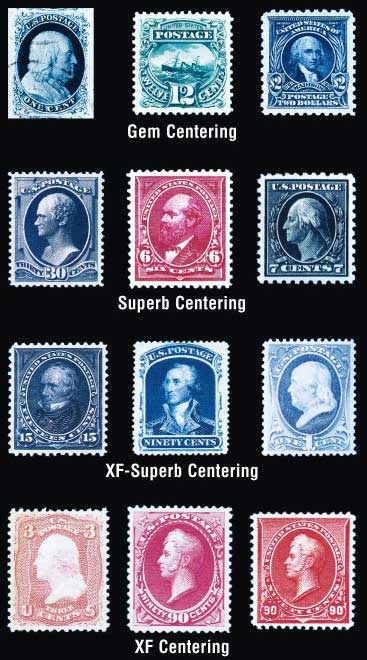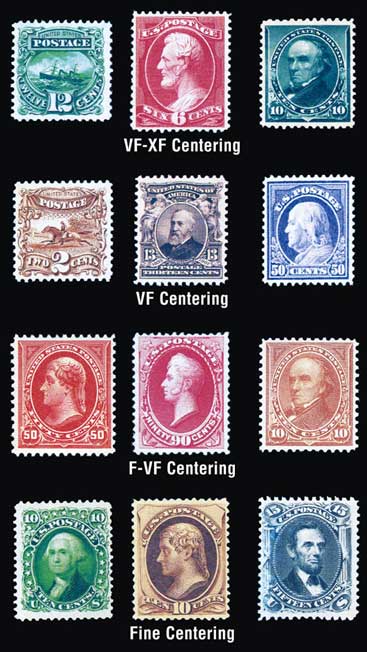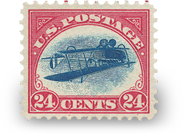| Introduction | Why Grade Stamps? | What is Grading? | PSE Grading System | Soundness | Centering | Combining Soundness and Centering | Eye Appeal | Gum Condition | Appendix |
A stamp whose design is well centered within four nearly equal margins is aesthetically more pleasing than one that is "off" on one or two sides. Because of this, stamps with perfect, or near perfect centering have traditionally sold for more money than those that are visibly off center.
As the perforation process occurs after printing, a very slightly misaligned sheet may result in the perforations being closer to the design on one or two sides. Grading the centering of a stamp is complicated by the fact that improving production methods over the past century and a half have resulted in more accurate and precise perforating techniques. Consequently, what may be above average centering for an early issue may be only average or even below average for a modern issue.
Traditional discussions of centering have usually broken stamps into three categories; poorly centered issues (typically 19th century), median-centered issues (early 20th century) and well-centered issues (later 20th century). While this approach is certainly logical and reflective of technological progress, it is flawed in the sense that what may be "Very Fine" for one issue is only "Fine" for another. The expertise needed to know which issues are typically poorly centered is considerable, and confusion often results on the part of the novice, and even the intermediate buyer.
PSE therefore strives to apply only one centering standard for all U.S. stamps with the exception of the first perforated issue of 1857 to 1861 (Scott Nos. 18-38), and their corresponding reprints of 1875 (Scott #41 through #46) and the 5, 24 and 30 issues of 1861 (Scott Nos. 67, 70, 71, 75, 76, 78 and their grilled counterparts). The 1857 stamps were originally designed as imperforates, and because the margins are often virtually non-existent, the perforations are often touching the design even on well-centered examples. Aside from these pre-Civil War issues and the few 1861 issues, the remaining U.S. stamps are evaluated using a single, consistent criterion. In this way, the standard can remain steady, and the listed market values can adjust appropriately.
The logic behind this can be easily understood using a non-philatelic example. Assume for example, a rare antique car is being offered - let's say a 1911 Buick. All the known 1911 Buicks (including this car) are rusty wrecks. But, this particular one is the least rusty, and the best one known. Should the car be described as being in "Excellent" or "Near Mint" condition? Of course not. Simply because it is nice for a 1911 Buick does not change its actual condition. It might accurately be described as "only fair, finest known." Those who want an example of this car will therefore bid accordingly, and the car may realize a handsome price. But its rarity does not affect its grade or condition.
Using a philatelic example, the PSE centering standard for Scott No. 596, a rare and typically poorly centered stamp is consequently the same as that for Scott No. 595, a stamp that comes in the full range of centering. In this way, superb centering is just that, and there is no such thing as a Scott No. 596, "Superb" for issue. The inconsistency and confusion resulting from a "relative" scale is obvious. According to the PSE centering standard, the best-centered Scott No. 596 in existence is only Fine, but the market retail price for this centering can still exceed $100,000.
| Gem | Four visually equal margins. Even after a careful examination, it will be impossible to pick a margin smaller than the other three. |
| Superb | A Superb stamp will be extremely well centered, and it may take up to ten seconds to ascertain that the stamp is not perfectly centered. One side may be very slightly smaller than its opposite, though certainly not apparent unless the stamp is carefully studied. |
| XF-Superb | A stamp of this grade will be very well centered, and at first glance will appear very nearly perfect. It will typically require a few seconds of examination to determine which margin is slightly smaller than the others. |
| Extremely Fine | The stamp will be well centered, though a brief examination will reveal that the stamp is slightly off center. All four margins will be generous in size for the issue. |
| VF-XF | A Very Fine to Extremely Fine stamp will appear slightly off center in one or two directions at first glance, but will unquestionably be better centered than most examples. The margins will be full with room to spare. |
| Very Fine | A Very Fine stamp will be off center on one or two sides, but the framelines will not be close to the edge on any side. All four margins will be unquestionably full, and well clear of the perforations. |
| Fine-Very Fine | The stamp is noticeably off center with one or two sides significantly closer to the edge than the opposite side. But there is no question that there is white space between the frameline and the perforations. |
| Fine | A stamp that is quite off center on one or two sides with the edge of the design approaching the perforations. While close, the frameline cannot be touching the perfs. Some white space must be visible, though it may be very narrow. |
| Very Good | The edge of the frameline just touches the perfs on one side, but the perfs do not cut into the design. |
| Good | The perforations cut into the design, and some portion of the design is lost. |
| Very Poorly Centered Stamps | Stamps with exceptionally poor centering, where a significant portion of the design is lost and the perforations cut deeply into the stamp cross into the "freaks and oddities" area, and may actually begin to enjoy increased demand and value from collectors who value such anomalies. |




